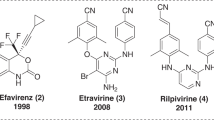Abstract
Despite of all the extensive research work done on recently developed diaryl pyrimidine analogues, thiazolidinedione analogues and indolyl aryl sulfones as HIV-1 reverse transcriptase (RT) inhibitors, there still continues the never-ending problem of resistance. In the present study, we have designed novel β-carboline analogues as inhibitor of HIV-1 RT. Molecular docking studies were performed using Autodock v4.2 against both wild and mutant strains of HIV-1 RT. Among the designed analogues, compound 9H3NH4CN, 9H6CNP and 9H4CN showed significant binding free energy against wild strain (−10.99, −12.06, −11.33 kcal/mol) and against mutant strain (−15.27, −13.9, −15.81 kcal/mol) of HIV-1 RT, respectively, as that of standard drugs efavirenz, rilpivirine against wild strain (−12.02, −8.55 kcal/mol) and against mutant strain (−10.81, −12.1 kcal/mol) of HIV-1 RT, respectively. The predicted inhibitory constant values (K i) of these compounds are against wild strain (8.8, 1.37, 4.92 nM) and against mutant strain (6.4, 64.43, 2.56 pM), respectively, as that of standard drugs efavirenz, rilpivirine against wild strain (1.6, 538.7 nM) and against mutant strain (11.8, 1.36 nM) of HIV-1 RT, respectively. In addition to this, molecular descriptors such as Lipinski drug likeness and ADMET properties were calculated using online servers like Molinspiration and admetSAR. These compounds can be further developed as next generation non-nucleoside reverse transcriptase inhibitors with promising anti HIV-1 activity with better pharmacokinetic profile.










Similar content being viewed by others

References
Bethune M (2010) Non-nucleoside reverse transcriptase inhibitors (NNRTIs), their discovery, development, and use in the treatment of HIV-1 infection: a review of the last 20 years (1989–2009). Antiviral Res 85:75–90
Cheng F, Li W, Zhou Y, Shen J, Wu Z, Liu G, Lee P, Tang Y (2012) admetSAR: a comprehensive source and free tool for assessment of chemical ADMET properties. J Chem Inf Model 52:3099–3105
De Clercq E (1998) The role of non-nucleoside reverse transcriptase inhibitors (NNRTIs) in the therapy of HIV-1 infection. Antiviral Res 38:153–179
Garrett M, Ruth H, William L, Michel S, Richard B, David G, Arthur O (2009) Autodock4 and autodocktools4: automated docking with selective receptor flexibility. J Comput Chem 30:2785–2791
Gilbert PB, McKeague IW, Eisen G, Mullins C, Guéye NA, Mboup S, Kanki PJ (2003) Comparison of HIV-1 and HIV-2 infectivity from a prospective cohort study in Senegal. Stat Med 22:573–593
Hedley P, Jorgensen P, Schlamowitz S, Wangari R (2009) The genetic basis of long QT and short QT syndromes: a mutation update. Hum Mutat 30:1486–1511
Leigh AJ, Frost SD, Mathews WC, Dawson K, Hellmann NS, Daar ES, Richman DD, Little SJ (2003) Transmission fitness of drug-resistant human immunodeficiency virus and the prevalence of resistance in the antiretroviral-treated population. J Infect Dis 187:683–686
Lipinski CA, Lombardo F, Dominy BW, Feeney PJ (2001) Experimental and computational approaches to estimate solubility and permeability in drug discovery and development settings. Adv Drug Deliv Rev 46:3–26
Maga G, Spadari S (2002) Combinations against combinations: associations of anti-HIV 1 reverse transcriptase drugs challenged by constellations of drug resistance mutations. Curr Drug Metab 3:73–95
Ragno R, Artico M, Martino G, Regina G, Coluccia A, Pasquali A, Silvestri R (2005) Docking and 3-D QSAR studies on indolyl aryl sulfones. Binding mode exploration at the HIV-1 reverse transcriptase non-nucleoside binding site and design of highly active N-(2-hydroxyethyl)carboxamide and N-(2-hydroxyethyl) carbohydrazide derivatives. J Med Chem 48:213–223
Richman DD, Morton SC, Wrin T, Hellmann N, Berry S, Shapiro MF, Bozzette SA (2004) The prevalence of antiretroviral drug resistance in the United States. AIDS 18:1393–1401
Sanguinetti MC, Tristani-Firouzi M (2006) hERG potassium channels and cardiac arrhythmia. Nature 440:463–469
Schüttelkopf AW, Van Aalten DMF (2004) PRODRG—a tool for high-throughput crystallography of protein–ligand complexes. Acta Crystallogr 60:1355–1363
Valdez RH, Tonin LTD, Nakamura TU, Filho BPD, Diaz JAM, Sarragiotto MH, Nakamura CV (2009) Biological activity of 1,2,3,4-tetrahydro-b-carboline-3-carboxamides against Trypanosoma cruzi. Acta Trop 110:7–14
Umamaheswari M, Aji CS, Asokkumar K, Sivashanmugam T, Subhadradevi V, Jagannath P, Madeswaran A (2012) Docking studies: In silico aldose reductase inhibitory activity of commercially available flavonoids. Bangladesh J Pharmacol 7:108–113
Author information
Authors and Affiliations
Corresponding author
Rights and permissions
About this article
Cite this article
Ashok, P., Sharma, H., Lathiya, H. et al. In-silico design and study of novel piperazinyl β-carbolines as inhibitor of HIV-1 reverse transcriptase. Med Chem Res 24, 513–522 (2015). https://doi.org/10.1007/s00044-014-1141-7
Received:
Accepted:
Published:
Issue Date:
DOI: https://doi.org/10.1007/s00044-014-1141-7



